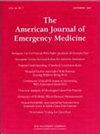An emergency medicine review: Multiple myeloma and its complications
IF 2.7
3区 医学
Q1 EMERGENCY MEDICINE
引用次数: 0
Abstract
Introduction
Multiple myeloma (MM) and its complications carry a high rate of morbidity and mortality.
Objective
This review evaluates MM and its complications, including presentation, diagnosis, and management in the emergency department (ED) based on current evidence.
Discussion
MM is the second most common hematologic cancer and associated with monoclonal plasma cell proliferation. The presentation of MM varies, ranging from few symptoms to end organ injury and failure. The most common presenting findings include anemia, bone pain, renal injury, fatigue, hypercalcemia, and weight loss. While clinical outcomes have improved with known therapies, a variety of complications may occur. Anemia is the most common hematologic complication, though hyperviscosity syndrome, bleeding, and coagulopathy may occur. Renal injury is common, and hypercalcemia is the result of bone demineralization. Infection is a major cause of morbidity and mortality. Osteolytic bone disease is a significant feature of MM, present in 70 % of patients, which may result in pathologic and insufficiency fractures. The most serious neurologic complication includes spinal cord compression, and other neurologic complications include peripheral neuropathy and intracranial involvement. Cardiac toxicity may occur with MM therapies, and there is also increased risk of venous thromboembolism. Endocrine complications may also occur, including adrenal insufficiency and thyroid dysfunction.
Conclusions
An understanding of the complications of MM can assist emergency clinicians in diagnosing and managing this potentially deadly disease.
急诊医学综述:多发性骨髓瘤及其并发症。
简介:多发性骨髓瘤(MM)及其并发症具有很高的发病率和死亡率。目的:本综述基于现有证据评估MM及其并发症,包括表现、诊断和急诊(ED)的处理。讨论:MM是第二常见的血液病,与单克隆浆细胞增殖有关。MM的表现各不相同,从症状少到终末器官损伤和衰竭。最常见的表现包括贫血、骨痛、肾损伤、疲劳、高钙血症和体重减轻。虽然已知的治疗方法改善了临床结果,但可能会出现各种并发症。贫血是最常见的血液学并发症,尽管高粘度综合征、出血和凝血功能障碍也可能发生。肾损伤是常见的,高钙血症是骨脱矿的结果。感染是发病和死亡的主要原因。溶骨性骨病是MM的重要特征,70%的患者存在,可导致病理性和不全性骨折。最严重的神经系统并发症包括脊髓压迫,其他神经系统并发症包括周围神经病变和颅内受累。心脏毒性可能发生与MM治疗,也有静脉血栓栓塞的风险增加。内分泌并发症也可能发生,包括肾上腺功能不全和甲状腺功能障碍。结论:了解MM的并发症可以帮助急诊临床医生诊断和管理这种潜在的致命疾病。
本文章由计算机程序翻译,如有差异,请以英文原文为准。
求助全文
约1分钟内获得全文
求助全文
来源期刊
CiteScore
6.00
自引率
5.60%
发文量
730
审稿时长
42 days
期刊介绍:
A distinctive blend of practicality and scholarliness makes the American Journal of Emergency Medicine a key source for information on emergency medical care. Covering all activities concerned with emergency medicine, it is the journal to turn to for information to help increase the ability to understand, recognize and treat emergency conditions. Issues contain clinical articles, case reports, review articles, editorials, international notes, book reviews and more.

 求助内容:
求助内容: 应助结果提醒方式:
应助结果提醒方式:


